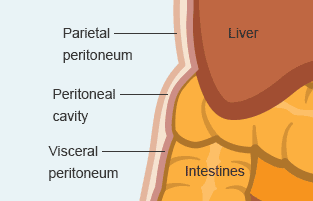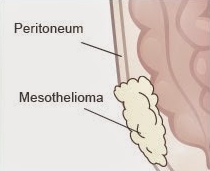Peritoneal Mesothelioma
Posted on Thursday, April 28th, 2016 at 8:43 am
Peritoneal Mesothelioma Explained

Peritoneal Mesothelioma – Peritoneum Diagram
Peritoneal mesothelioma is the second commonest type of mesothelioma. It accounts for up to 20% of all mesothelioma cases. An estimate of between 250 to 500 new cases of peritoneal mesothelioma are reported each year in the U.S. It is caused by exposure to asbestos, such exposure leads to the inhalation and/or swallowing of tiny asbestos fibers. The name peritoneal mesothelioma comes from the area where the cancer develops, which is along the peritoneum. The peritoneum is a protective layer that lines or surrounds the abdomen. There are two layers, the parietal layer which lines the abdominal cavity and the visceral layer which surrounds the stomach, liver and other organs. The layers support the whole abdominal cavity including the organs in it.
How asbestos causes peritoneal mesothelioma

Peritoneal Mesothelioma
Swallowed asbestos fibers travel from the digestive system to the peritoneum through the lymphatic system; that is through the lymph nodes which produce and store cells that fight disease. The asbestos fibers irritate the cells and the peritoneal lining starts to thicken. As the cancer develops excess fluid builds up in the abdomen. Over a period of time, tumors form and put pressure on the organs in the abdominal cavity. The main effects caused by the asbestos fibers are:
- Inflammation and thickening of the peritoneum
- Buildup of fluid
- Formation of tumors
Symptoms
Peritoneal mesothelioma symptoms appear 20-50 years after the initial exposure to asbestos. Some of the symptoms are:
- Abdominal swelling or pain
- Diarrhea or constipation
- Nausea or vomiting
- Fatigue
- Hernia
- Anemia
- Sudden weight loss
- Night sweats or fever
- A feeling of being full
Prognosis
Generally, doctors who specialize in treating peritoneal mesothelioma project a life expectancy of twelve months. However, the combination of surgery and heated chemotherapy treatment can extend survival by several years. Survival chances are increased by early detection of the disease as this allows for more treatment options.